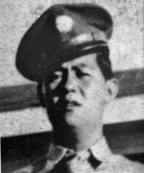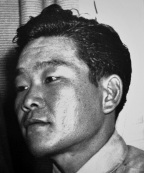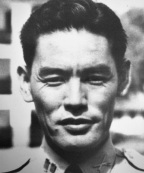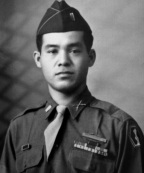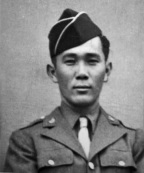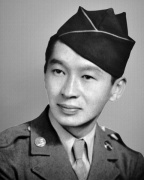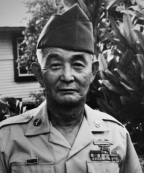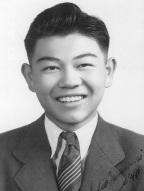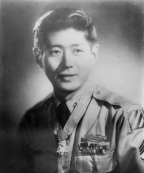PRIVATE MIKIO HASEMOTO
Private Mikio Hasemoto distinguished himself by extraordinary heroism in action on 29 November 1943, in the vicinity of Cerasuolo, Italy. A force of approximately 40 enemy soldiers armed with machine guns, machine pistols, rifles, and grenades attacked the left flank of his platoon.Two enemies with machine guns advanced forward, firing their weapons. Private Hasemoto, an automatic rifleman, challenged these two machine gunners. After firing four magazines at the approaching enemy, his weapon was shot and damaged. Unhesitatingly, he ran 10 yards to the rear, secured another automatic rifle and continued to fire until his weapon jammed. At this point, Private Hasemoto and his squad leader had killed approximately 20 enemy soldiers. Again, Private Hasemoto ran through a barrage of enemy machine gun fire, to pick up an M-1 rifle. Continuing their fire, Private Hasemoto and his squad leader killed 10 more enemy soldiers. With only three enemy soldiers left, he and his squad leader charged courageously forward, killing one, wounding another, and capturing the remaining enemy. The following day, Private Hasemoto continued to repel enemy attacks until he was killed by enemy fire. Private Hasemoto’s extraordinary heroism and devotion to duty are in keeping with the highest traditions of military service and reflect great credit on him, his unit, and the United States Army.
PRIVATE SHIZUYA HAYASHI
Private Shizuya Hayashi distinguished himself by extraordinary heroism in action on 29 November 1943, near Cerasuolo, Italy. During a flank assault on high ground held by the enemy, Private Hayashi rose alone in the face of grenade, rifle, and machine gun fire. Firing his automatic rifle from the hip, he charged and overtook an enemy machine gun position, killing seven men in the nest and two more as they fled. After a platoon advance of 200 yards from this point, an enemy antiaircraft gun-position opened fire on the platoon. Private Hayashi returned fire at the hostile position, killing nine of the enemy, taking four prisoners, and forcing the remainder of the force to withdraw from the hill. Private Hayashi’s extraordinary heroism and devotion to duty are in keeping with the highest traditions of military service and reflect great credit on him, his unit, and the United States Army.
The December 2002 issue of the Puka Puka Parade includes a salute to Private Hayashi, one of the two surviving 100th veterans who attended the June 21, 2000 ceremony in Washington, D.C. where they were presented with the Medal of Honor by President Bill Clinton. http://hdl.handle.net/10524/18702
STAFF SERGEANT ALLAN M. OHATA
Staff Sergeant Allan M. Ohata distinguished himself by extraordinary heroism in action on 29 and 30 November 1943, near Cerasuolo, Italy. Staff Sergeant Ohata (then Sergeant), his squad leader, and three men were ordered to protect his platoon’s left flank against an attacking enemy force of 40 men, armed with machine guns, machine pistols, and rifles. He posted one of his men, an automatic rifleman, on the extreme left, 15 yards from his own position. Taking his position, Staff Sergeant Ohata delivered effective fire against the advancing enemy. The man to his left called for assistance when his automatic rifle was shot and damaged. With utter disregard for his personal safety, Staff Sergeant Ohata left his position and advanced 15 yards through heavy machine gun fire. Reaching his comrade’s position, he immediately fired upon the enemy, killing 10 enemy soldiers and successfully covering his comrade’s withdrawal to replace his damaged weapon. Staff Sergeant Ohata and the automatic rifleman held their position and killed some 37 enemy soldiers. Then both men charged the three remaining soldiers and captured them. Later, Staff Sergeant Ohata and the automatic rifleman stopped another attacking force of 14, killing four and wounding three while the others fled. The following day, he and the automatic rifleman held their flank with grim determination and staved off all attacks. Staff Sergeant Ohata’s extraordinary heroism and devotion to duty are in keeping with the highest traditions of military service and reflect great credit on him, his unit, and the United States Army.
Ben Tamashiro’s 1985 article on Staff Sergeant Ohata.
TECHNICAL SERGEANT YEIKI KOBASHIGAWA
Technical Sergeant Yeiki Kobashigawa distinguished himself by extraordinary heroism in action on 2 June 1944, in the vicinity of Lanuvio, Italy. During an attack, Technical Sergeant Kobashigawa’s platoon encountered strong enemy resistance from a series of machine guns providing supporting fire. Observing a machine gun nest 50 yards from his position, Technical Sergeant Kobashigawa crawled forward with one of his men, threw a grenade and then charged the enemy with his submachine gun while a fellow soldier provided covering fire. He killed one enemy soldier and captured two prisoners. Meanwhile, Technical Sergeant Kobashigawa and his comrade were fired upon by another machine gun 50 yards ahead. Directing a squad to advance to his first position, Technical Sergeant Kobashigawa again moved forward with a fellow soldier to subdue the second machine gun nest. After throwing grenades into the position, Technical Sergeant Kobashigawa provided close supporting fire while a fellow soldier charged, capturing four prisoners. On the alert for other machine gun nests, Technical Sergeant Kobashigawa discovered four more, and skillfully led a squad in neutralizing two of them. Technical Sergeant Kobashigawa’s extraordinary heroism and devotion to duty are in keeping with the highest traditions of military service and reflect great credit on him, his unit, and the United States Army.
The January 2003 issue of the Puka Puka Parade includes an article by his daughter Jill describing the June 21, 2000 ceremony in Washington, D.C. when surviving veterans were presented with the Medal of Honor by President Bill Clinton. http://hdl.handle.net/10524/18703
PRIVATE SHINYEI NAKAMINE
Private Shinyei Nakamine distinguished himself by extraordinary heroism in action on 2 June 1944 near La Torreto, Italy. During an attack, Private Nakamine’s platoon became pinned down by intense machine gun crossfire from a small knoll 200 yards to the front. On his own initiative, Private Nakamine crawled toward one of the hostile weapons. Reaching a point 25 yards from the enemy, he charged the machine gun nest, firing his submachine gun and killing three enemy soldiers and capturing two. Later that afternoon, Private Nakamine discovered an enemy soldier on the right flank of his platoon’s position. Crawling 25 yards from his position, Private Nakamine opened fire and killed the soldier. Then, seeing a machine gun nest to his front approximately 75 yards away, he returned to his platoon and led an automatic rifle team toward the enemy. Under the covering fire of the automatic rifle, Private Nakamine crawled to a point 25 yards from the nest and threw hand grenades at the enemy soldiers, wounding one and capturing four. Spotting another machine gun nest 100 yards to his right flank, he led the automatic rifle team toward the hostile position, but was killed by a burst of machine gun fire. Private Nakamine’s extraordinary heroism and devotion to duty are in keeping with the highest traditions of military service and reflect great credit on him, his unit, and the United States Army.
View photographs of Shinyei Nakamine and an essay by his sister.
PRIVATE MASATO NAKAE
Private Masato Nakae distinguished himself by extraordinary heroism in action on 19 August 1944, near Pisa, Italy. When his submachine gun was damaged by a shell fragment during a fierce attack by a superior enemy force, Private Nakae quickly picked up his wounded comrade’s M-1 rifle and fired rifle grenades at the steadily advancing enemy. As the hostile force continued to close in on his position, Private Nakae threw six grenades and forced them to withdraw. During a concentrated enemy mortar barrage that preceded the next assault by the enemy force, a mortar shell fragment seriously wounded Private Nakae. Despite his injury, he refused to surrender his position and continued firing at the advancing enemy. By inflicting heavy casualties on the enemy force, he finally succeeded in breaking up the attack and caused the enemy to withdraw. Private Nakae’s extraordinary heroism and devotion to duty are in keeping with the highest traditions of military service and reflect great credit on him, his unit, and the United States Army.
PRIVATE FIRST CLASS KAORU MOTO
Private First Class Kaoru Moto distinguished himself by extraordinary heroism in action on 7 July 1944, near Castellina, Italy. While serving as first scout, Private First Class Moto observed a machine gun nest that was impeding his platoon. On his own initiative, he made his way to a point ten paces from the hostile position, and killed the enemy machine gunner. Immediately, the assistant gunner opened fire in the direction of Private First Class Moto. Crawling to the rear of the position, Private First Class Moto surprised the enemy soldiers, who quickly surrendered. Taking his prisoner with him, Private First Class Moto took a position a few yards from a house to deny the enemy use of the building as an observation post. While guarding the house and his prisoner, he observed an enemy machine gun team moving into position. He engaged them, and with deadly fire forced the enemy to withdraw. An enemy sniper located in another house fired at Private First Class Moto severely wounding him. Applying first aid to his wound, he changed position to elude the sniper fire and to advance. Finally relieved of his position, he made his way to the rear for treatment. Crossing a road, he spotted an enemy machine gun nest. Opening fire, he wounded two of the three soldiers occupying the position. Not satisfied with this accomplishment, he then crawled forward to a better position and ordered the enemy soldier to surrender. Receiving no answer, Private First Class Moto fired at the position, and the soldiers surrendered. Private First Class Moto’s extraordinary heroism and devotion to duty are in keeping with the highest traditions of military service and reflect great credit on him, his unit, and the United States Army.
Ben Tamashiro’s 1985 article on PFC Moto.
PRIVATE FIRST CLASS SADAO S. MUNEMORI
He fought with great gallantry and intrepidity near Seravezza, Italy on 5 April 1945. When his unit was pinned down by grazing fire from the enemy’s strong mountain defense and command of the squad devolved on him with the wounding of its regular leader, he made frontal one-man attacks through direct fire and knocked out two machine guns with grenades. Withdrawing under murderous fire and showers of grenades from enemy emplacements, he had nearly reached a shell crater occupied by two of his men when an unexploded grenade bounced on his helmet and rolled toward his helpless comrades. He arose into the withering fire, dived for the missile and smothered its blast with his body. By his swift, supremely heroic action Private First Class Munemori saved two of his men at the cost of his own life and did much to clear the path for his company’s victorious advance.
More information on Sadao Munemori:
Smithsonian
Densho Encyclopedia
KOREAN WAR
CORPORAL HIROSHI HERSHEY MIYAMURA
Corporal Miyamura distinguished himself by conspicuous gallantry and intrepidity above and beyond the call of duty in action against the enemy near Taejon-ni, Korea, on 24 and 25 April 1951. On the night of 24 April, Company H was occupying a defensive position when the enemy fanatically attacked, threatening to overrun the position. Corporal Miyamura, a machine gun squad leader, aware of the imminent danger to his men unhesitatingly jumped from his shelter, wielding his bayonet in close hand-to-hand combat, killing approximately ten of the enemy. Returning to his position, he administered first aid to the wounded and directed their evacuation. As another savage assault hit the line, he manned his machine gun and delivered withering fire until his ammunition was expended. He ordered the squad to withdraw while he stayed behind to render the gun inoperative. He then bayoneted his way through infiltrated enemy soldiers to a second gun emplacement and assisted in its operation. When the intensity of the attack necessitated the withdrawal of the company, Corporal Miyamura ordered his men to fall back while he remained to cover their movement. He killed more than fifty of the enemy before his ammunition was depleted and he was severely wounded. He maintained his magnificent stand despite his painful wounds, continuing to repel the attack until his position was overrun. When last seen, he was fighting ferociously against an overwhelming number of enemy soldiers. Corporal Miyamura’s indomitable heroism and consummate devotion to duty reflect the utmost glory on himself and uphold the illustrious traditions of the military service.
(Miyamura was subsequently captured, spending 27 ½ months in a Chinese prisoner of war camp near the Yalu River. Upon his release, he was told that he had been awarded the Medal of Honor. In October 1953, President Dwight Eisenhower presented the medal to him.)

